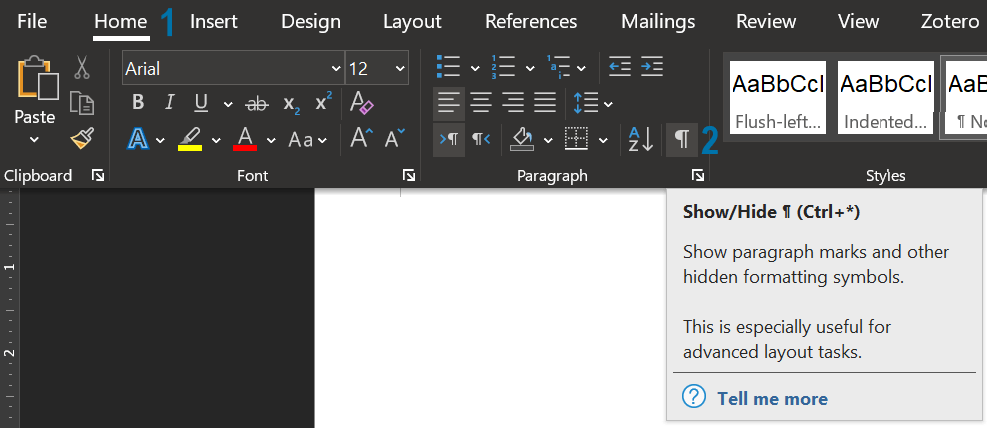If you delegate your title page formatting to Word, you can save yourself time spent formatting.1 You can also end up with a title page that’s more precisely formatted.
One key step to delegate this formatting work is to properly format your title page’s text. Another important, related step is to properly segment this text.
That is, each title page block needs to be its own single paragraph. That means the multi-line class block (block 3) and author block (block 4) each needs to be one paragraph with multiple lines.2
Use Paragraph Breaks and Line Breaks
When typing your title page, you should use a new paragraph (i.e., press Enter) only at the end of your
- Institution block (block 1),
- Title block (block 2),
- Class block (block 3), and
- Author block (block 4).
The class block (block 3) and author block (block 4) require three lines each. But within these blocks, you should use line breaks and not new paragraphs.
To insert a line break after the first two lines in each block, press Shift+Enter rather than simply Enter.
Visually on the page, a line break might not look much different to you than a paragraph break.
But from Word’s perspective, there’s an important difference that you can use to vastly simplify the vertical distribution of these blocks on your title page.
Using line breaks will keep the class block and author block together as single paragraphs from Word’s perspective.
And because they’re single paragraphs, Word can then distribute them evenly along with the other one-line paragraph blocks on the page (blocks 1 and 2).
Replace Paragraph Breaks with Line Breaks If Needed
If you haven’t already used line breaks within your class block (block 3) and author block (block 4), that’s okay.
You can simply delete the extra paragraph breaks you inserted and replace them with line breaks.
To check or replace the breaks on your title page, it might be easiest if you show hidden characters either from the keyboard (Ctrl+*) or from the “Home” tab.

After you show the hidden characters, you should see the line break symbol (↩) after
- Your instructor’s name,
- “IN PARTIAL FULFILLMENT OF”,
- “BY”, and
- Your name.
If you see a new paragraph symbol (¶) instead of a line break symbol in any of these places, simply delete that paragraph, and enter a line break instead (Shift+Enter). You should then see the line break symbol instead of the new paragraph symbol.
Then, in future title pages, you can use line breaks in these places from the start. That will keep you from having to correct the breaks later like you might have needed to do this time around.
Once you’ve traded out any new paragraphs for line breaks, you should still see the new paragraph symbol after
- The institution block (block 1),
- The title block (block 2),
- Your course number and title (the last line of block 3)
After your submission date (the last line of block 4), you should not see either the line break or the new paragraph symbol.
Instead, you should simply see the section break that ends your title page if you’ve set up your document’s sections like I recommend.
Conclusion
Once you have your title page text formatted and your title page blocks prepared, all that’s left is evenly distributing these blocks on your title page.

Tired of fighting with Word? Want to be done with frustrated hours fussing over how to get the formatting you need?
My new guide shows you how to bypass all of this so you can let Word work for you while you focus on your research.

For students in any graduate program, mastering the full range of available research tools is crucial for efficient and consistent productivity. Dr. Stark has mastered these tools—the most important of which is Microsoft Word…. Students eager to take their work to the next level would do well to follow Dr. Stark’s in-depth guidance.
Header image provided by Etienne Girardet. ↩
In these comments, I’m assuming you’re trying to format your title page as specified in Melanie Greer Nogalski et al., Student Supplement for The SBL Handbook of Style, Second Edition, ed. Joel M. LeMon and Brennan W. Breed, rev. ed. (Atlanta: SBL, 2015), §§2.8, 3.1. For an overview of the four title page blocks that the Student Supplement requires, see “The Fundamentals of How to Format a Title Page.” In the steps illustrated here, I’m assuming you’re using the most current version of Word available via an Office 365 subscription. As of this writing, that’s 16.0.12624.20278. Any reasonably recent version of Word should work similarly. But increasingly older versions may have increasingly larger differences in how they match the steps I describe here. ↩

Leave a Reply